Serie A has been turbulent this season with a few teams moving up and down the table and changing coaches in the blink of an eye. Some teams managed to cope with their temporary shaken performance, others slowly but surely dropped closer to the relegation zone.
One of these teams is Torino. The team are not performing to their potential this season, and while at the beginning of the campaign they seemed to have found a comfortable balance between the lines, in the second half of it things looked completely different.
There was a noticeable drop in their performance which forced the club to part ways with the manager Walter Mazzari and appoint the ex-Frosinone coach Moreno Longo.
His first two games in charge weren’t any different than the previous defeats and the lack of motivation and energy in the players was evident.
In this tactical analysis, we will look into Torino’s tactics and performance and see what could be the reason for their move down the table away from the leaders Juventus.
Team strategy
Mazzari was very particular in what shape he wanted to see the team play. Completely relying on a three-man defensive line Torino employed a few different formations such as 3-4-1-2, 3-4-2-1 and 3-5-2. Although they couldn’t be recognised for outstanding tactical decisions, the team were balancing out their performance well-enough to keep their mid-table spot.
The lack of relatively good options on the bench was noticeable but their regular starting XI was able to cope with the difficulties game by game. At some point though, they started cracking under pressure and their performance drastically dropped, leading them to the 15th position in the table only two points clear from the relegation zone.
In the following sections, we will discuss their strategy in the different phases and see their main tactical traits.
Attacking phase
The team have been focusing their attacking efforts on the flanks, most frequently using the left side for creating shorts pass combinations on the edge of the final third. The attacking players would usually drop deeper in efforts to make the transition easier.
Torino’s main delivery method to the box is by crossing the ball which is a result of their actions focused on the flanks. They don’t rely upon through balls and smart passes as often as their opponents and the connection between midfield and attack is often lacking. The forward players often get isolated (being too centrally orientated) and the only way for their teammates to create opportunities for them is by advancing the ball on the wings and then crossing in efforts to reach them.
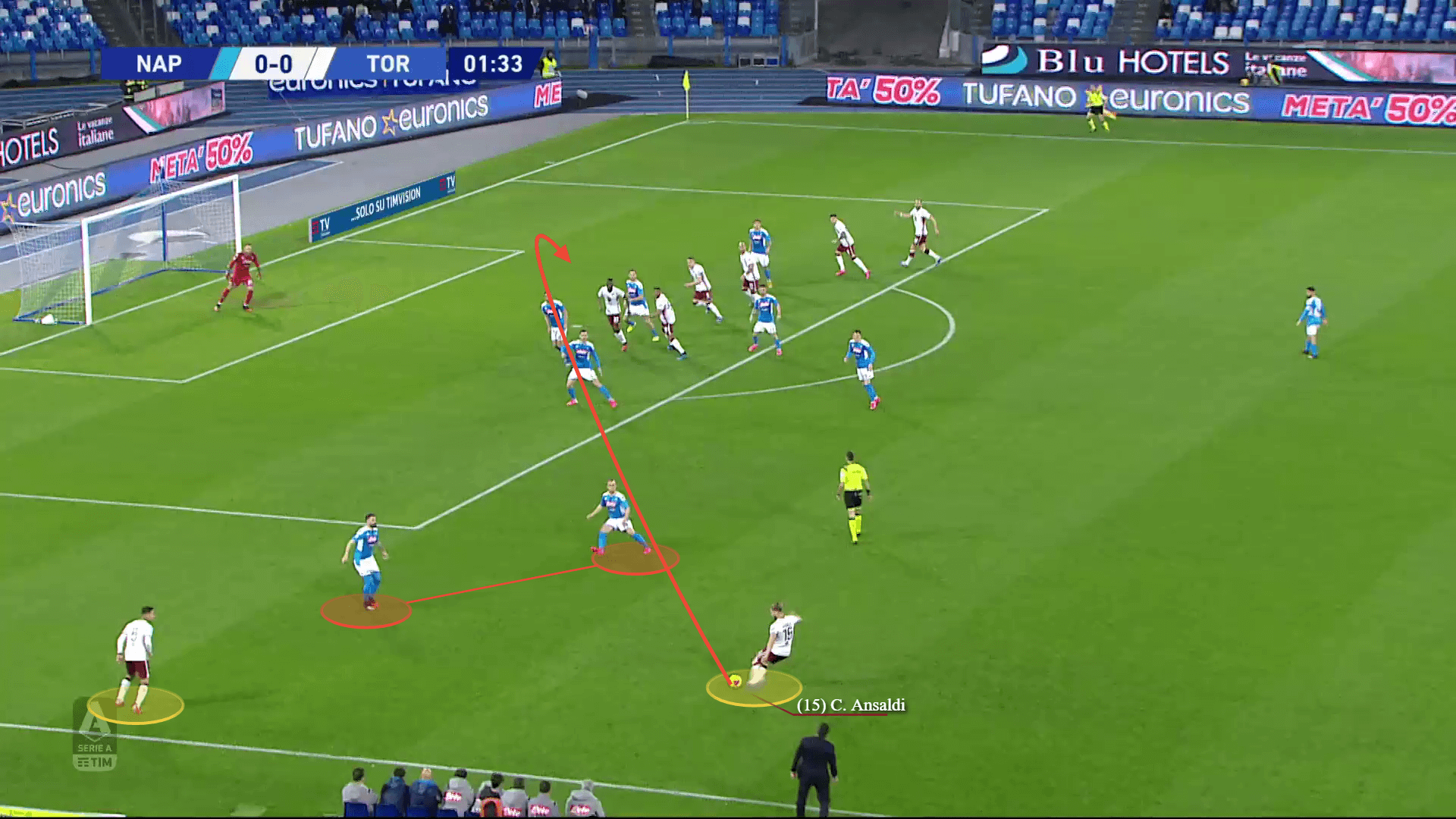
The team’s main man in attack, Andrea Belotti, is often tightly covered by the opposition’s players and his teammates find it difficult to break defences to reach him. His flair and strong decision-making are the reason he suffers quite a lot of fouls. Whilst they find it hard to create and exploit spaces, they do try to take advantage of these opportunities. Torino has scored five penalties and five goals from set-pieces this season, which adds up to almost half of their goals. The forward players usually drop deeper to pick up the ball but find it hard to penetrate afterwards. That’s why the team relies on playing long balls to break lines.
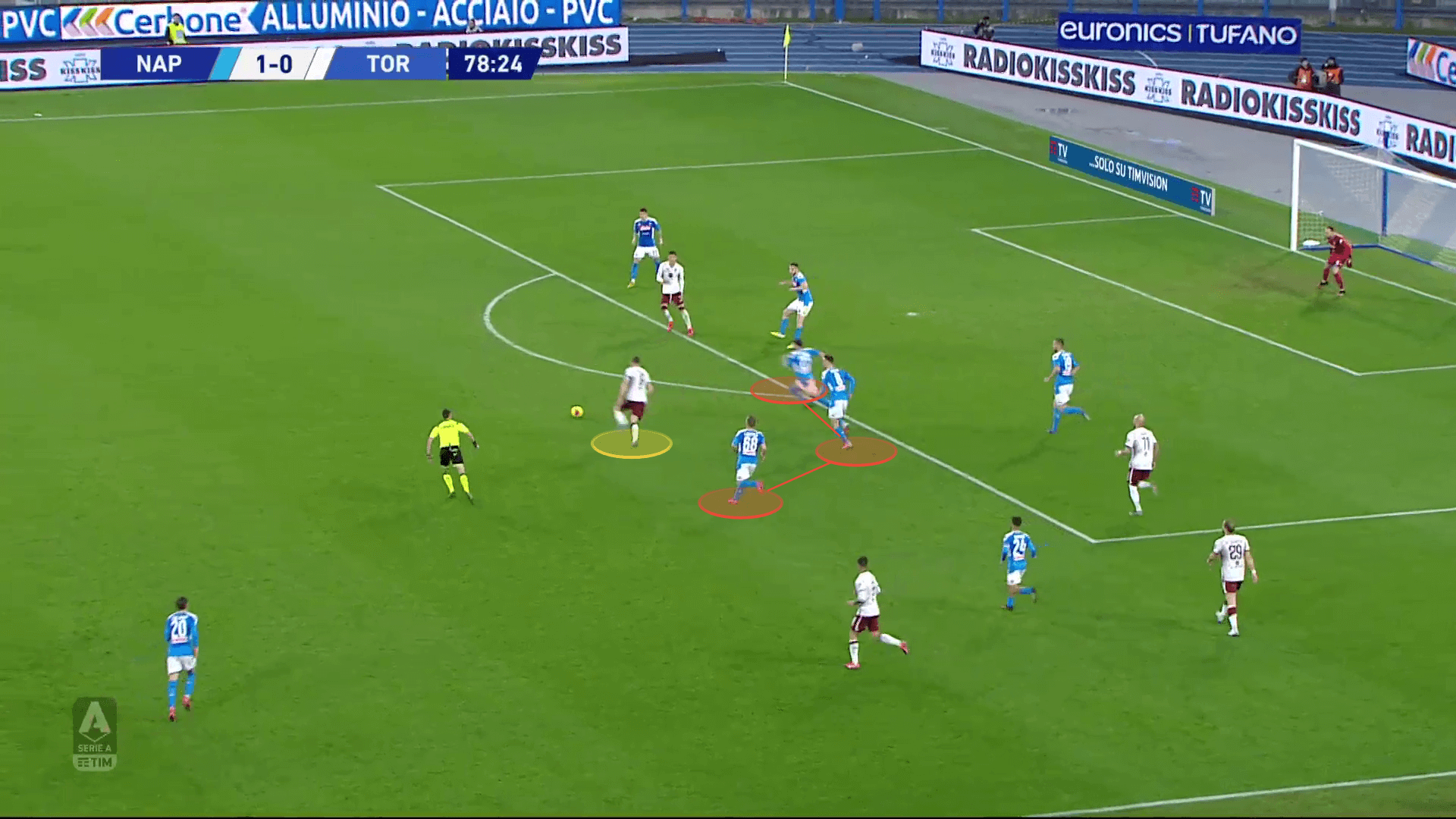
Their creativity decreased and the lack of different delivery methods affect Torino’s performance in front of the goal. The players often lack coordination in their off-ball movement in the final third due to being tightly marked and it often results in failed attacking actions.
It isn’t their attacking performance though that got them in the current position. Their 28 scored goals are equal to Milan’s scored goals who are currently 7th in the league.
Ball progression
Torino build-up from the back and usually use the left flank for ball progression. They create triangles on the side with the help of the left centre-back, left wing-back and the left central midfielder in order to retain possession and advance the ball. By using frequent short-pass combinations they try to bypass the press, although their efforts are not always successful.
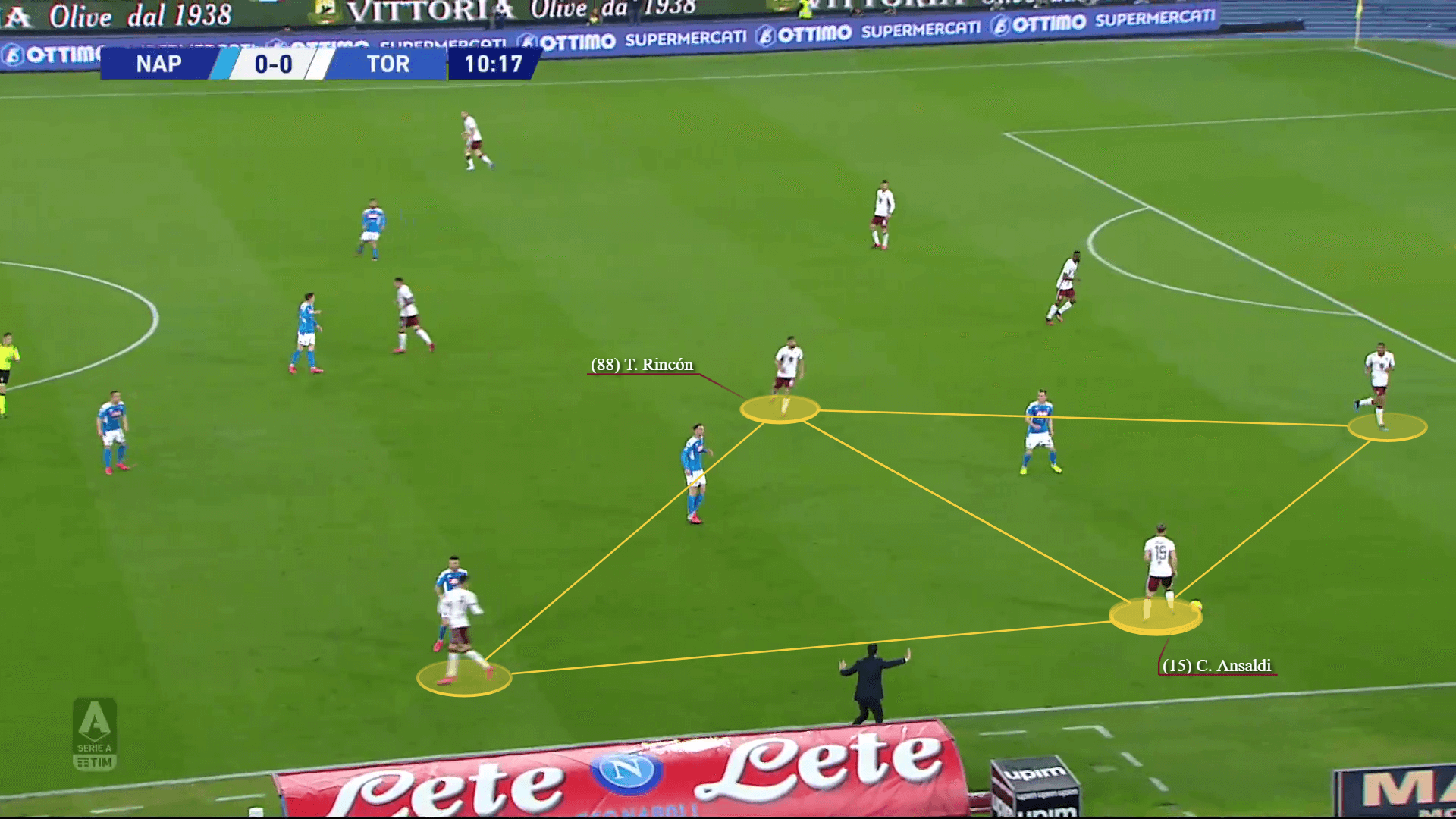
Due to that, they don’t focus on playing possession football and have adjusted to using direct long balls. Their 42.17 efforts per 90 minutes put them sixth in the league when it comes to frequency. Another reason for relying on long balls to the final third is that they frequently fail in keeping their structure and the spaces between the lines and the players increase. This affects their connection and their chances to build-up smoothly.
Despite their individual abilities, the Torino players often fail in their smart positioning when it comes to opening new passing lanes and creating space for each other. That’s why they get stuck in midfield trying to escape by attempting long balls or using the wings to distribute the ball to the final third.
They also attempt to switch flanks when they can’t escape the pressure, but as the season progressed they became pretty predictable for their opponents. They fail to adjust their strategy in-game which leaves them wandering all over the pitch without a clear idea how to advance the ball.
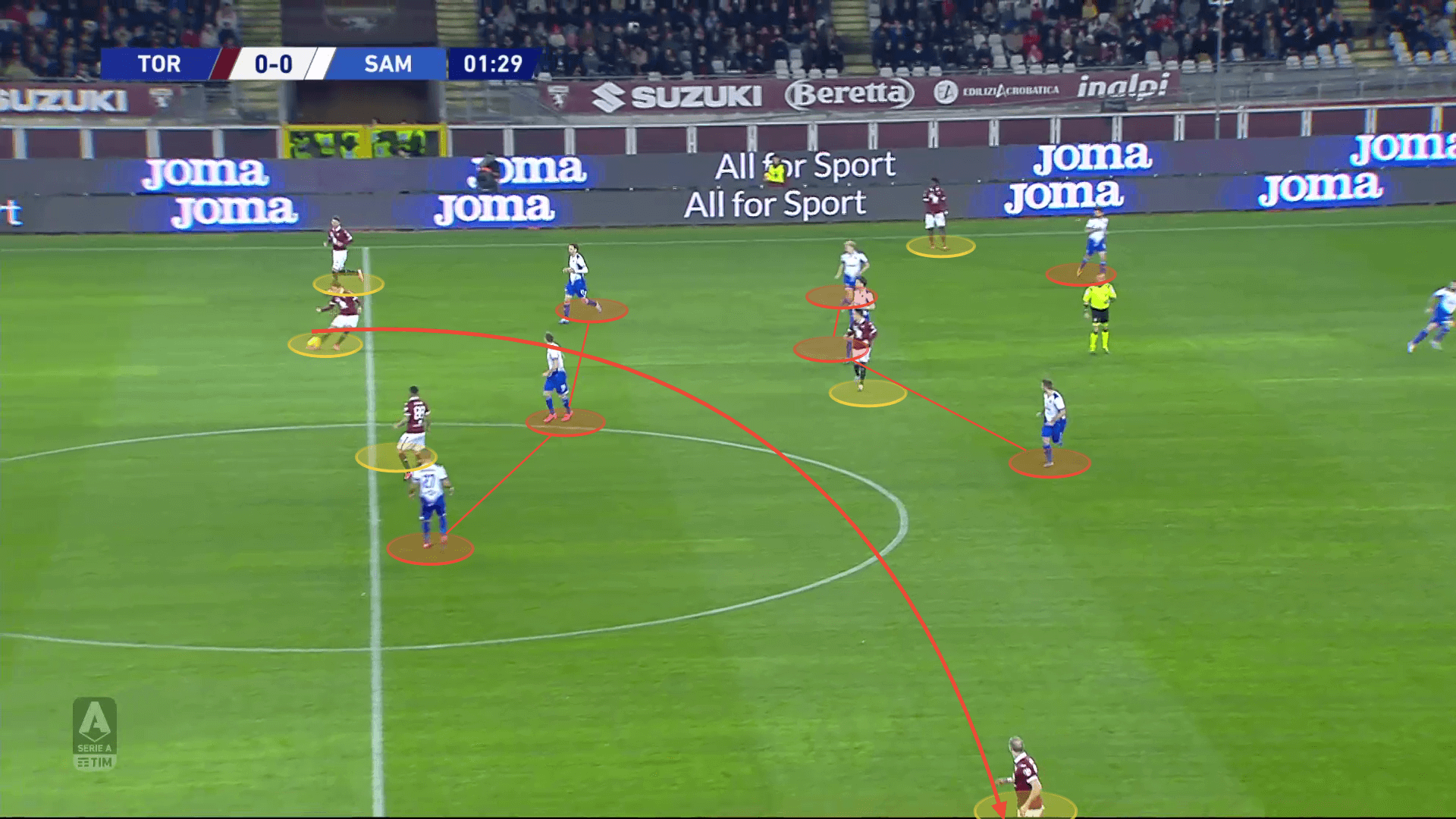
Their strategy of exploiting the flanks involves certain movement by the wing-backs and the attacking players. For the wing-backs to join the attacking ventures and have space, the front three would get narrow and often stay deeper than usual for their position. Relying on runs to the box and receiving crosses seems to work better for them than penetrating in the central areas.
Defensive phase
The team’s defensive actions often start with their attacking players applying a high press to trouble the opposition build-up. They would try forcing their opponents into mistakes or to sending the ball out wide in order to control their actions better on the flanks where the wing-backs would press. That wouldn’t always be a successful strategy though.
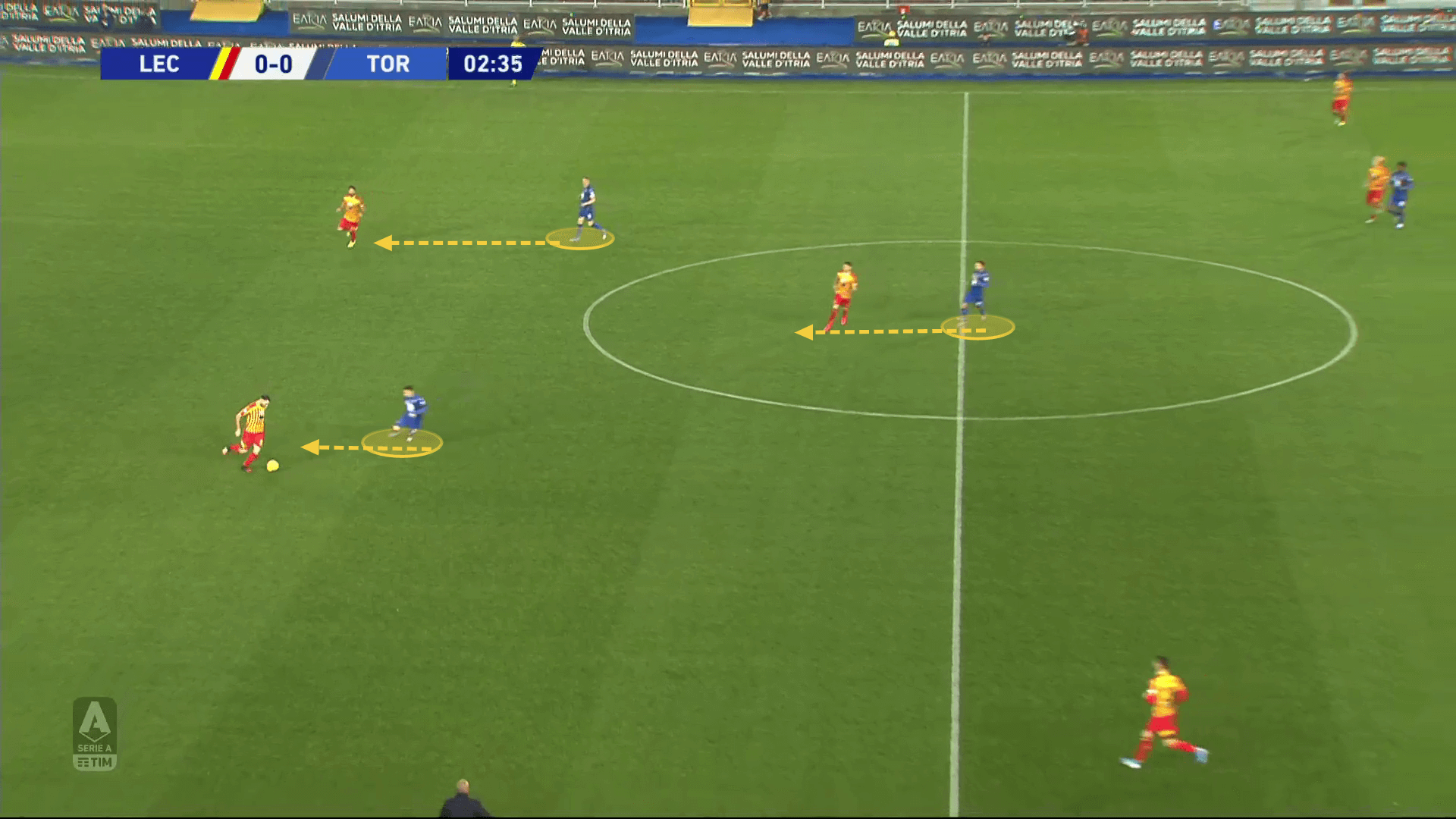
As mentioned previously Torino employs a three-man defence, which is often the reason for their vulnerability. Even though they have stuck to this strategy for a long time now, they still don’t seem completely aware of how to protect their wings.
They struggle defending against pacey and skilful players which is often a reason for the team being exposed in wide areas.
Most of the times their backline is positioned in a mid-block, often inviting pressure into their half. The problem though isn’t their positioning but their awareness. The defenders struggle to cope with the pressure, especially against teams that overcommit players to the final third actions.
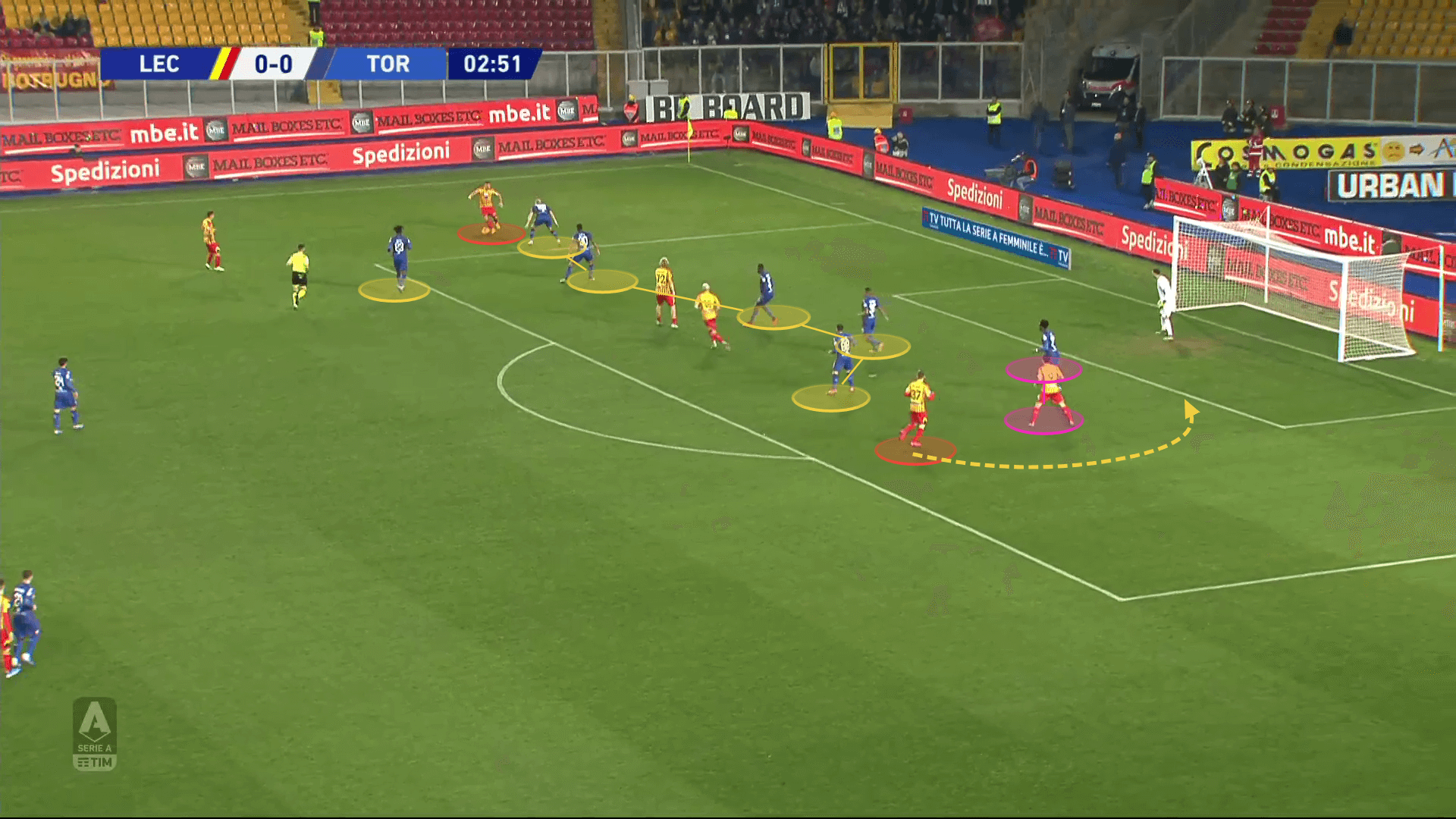
As you can probably notice, their defensive actions cause them a lot of trouble, which is the reason we are going to focus on them in-depth later on as part of the reason for their drop in performance.
Squad depth
Il Toro has quite a consistent starting XI. This could be very beneficial to building a strong connection and executing the strategy well, but in Torino’s case, not being able to rest their key players has affected their performance.
We won’t be doing a scout report on all their players, but we will discuss their options in the different areas. Their lack of decent options upfront, leave Belotti in a bad position. The player needs someone to combine with him and work both as a deliveryman and direct threat. The team don’t have enough attacking players to be able to split responsibilities. Having a creative distributor in the central areas, having direct threat with strong off-the-ball movement and also players to add additional bodies in the box looks like mission impossible for the team.
Although, as we’ll discuss later their defensive actions are their biggest vulnerability and a lot of it comes from the lack of versatility in midfield. Some of the team’s best performers occupy the central areas but they can’t be used to their full potential due to the absence of clearly defined roles, especially when defending.
Therefore, the connection with the backline struggles and combined with the lack of a strong leading figure at the back, it results in the team being exposed.
What is the reason for the drop in performance?
Looking at Torino’s defensive actions there are a few flaws that have affected their overall performance. The three-man defensive line often could not cope with teams that build their attacks quickly and with one-touch passes. The team struggle to cover the wings, which is another proof of their lack of connection between the lines. The poor partnership between the wing-backs and the centre-backs during defensive transitions often result in them acting hastily and leaving gaps in dangerous areas.
Due to their lack of structure, the team are often forced into individual mistakes or into acting aggressively to deal with the pressure. This results in them committing a lot of fouls which may not have been their biggest problem if they were organised in the box, but their actions are often wrongly timed and lack precision. They have allowed 10 goals from set-pieces this season. Even worse, the defensive players’ decision-making is often poor and they commit these fouls in dangerous areas which resulted in seven conceded penalties this term.
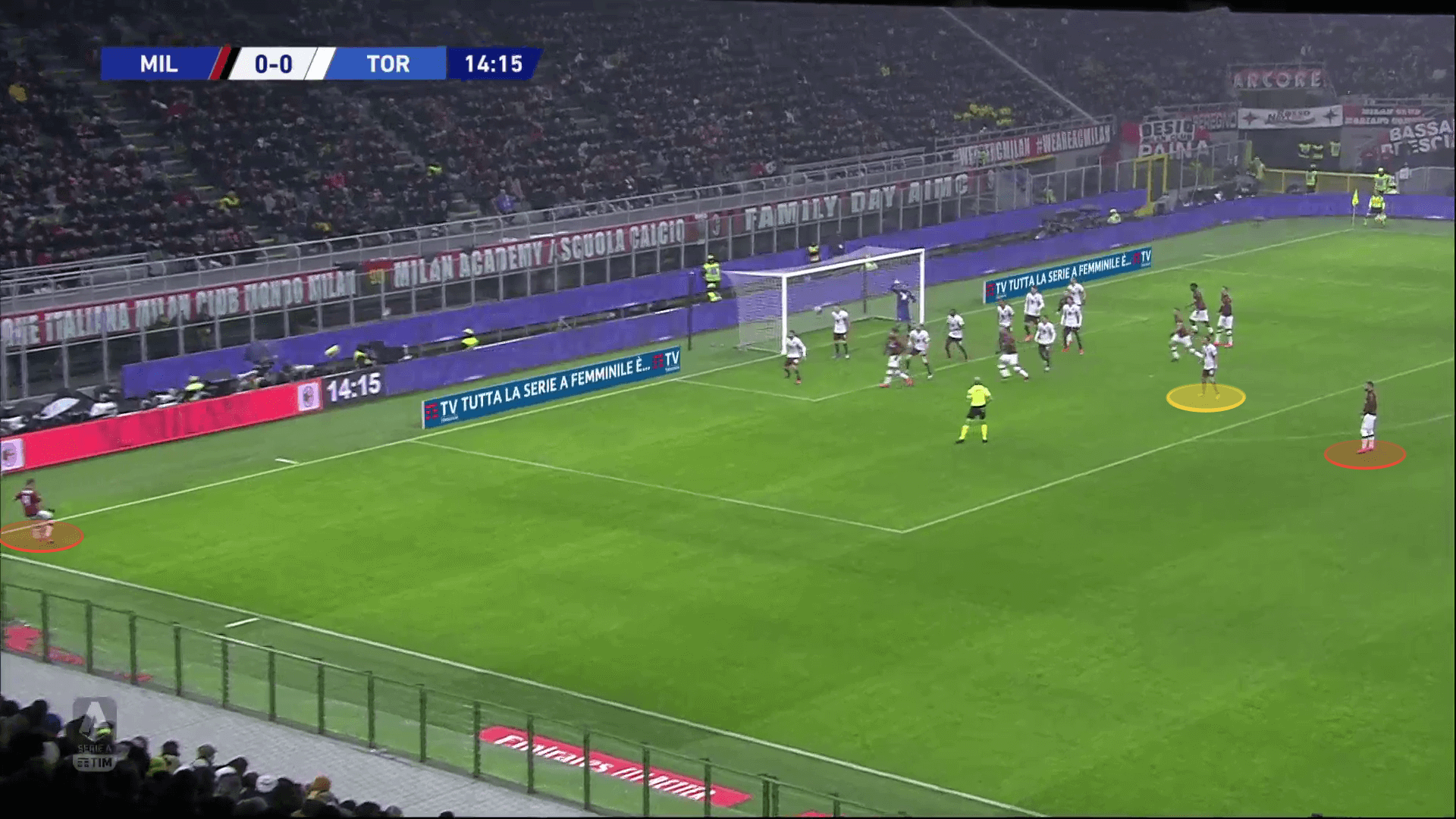
Expectedly, they fail to cover the gaps when caught on a counter too. Torino’s lack of coordination and pace makes them an easy target for teams that counter-attack frequently and have skilful players upfront.
They find it hard to stop teams that perform speedy attacks overall. Their defence would often be late during the defensive transition, especially after attacking set-pieces. This would result in chaotic actions and most frequently with a dangerous opportunity for the opposition in front of the goal.
Their failure to provide enough coverage for the skilful attacking players is also a huge problem since they rarely consider their off-ball movements. Even since the start of the season, they have been struggling with this and it was extremely noticeable in their 0-7 defeat against Atalanta. Their opponents were very attack-minded and creative as per usual and Torino couldn’t defend against Atalanta’s quick movement and short pass combinations.
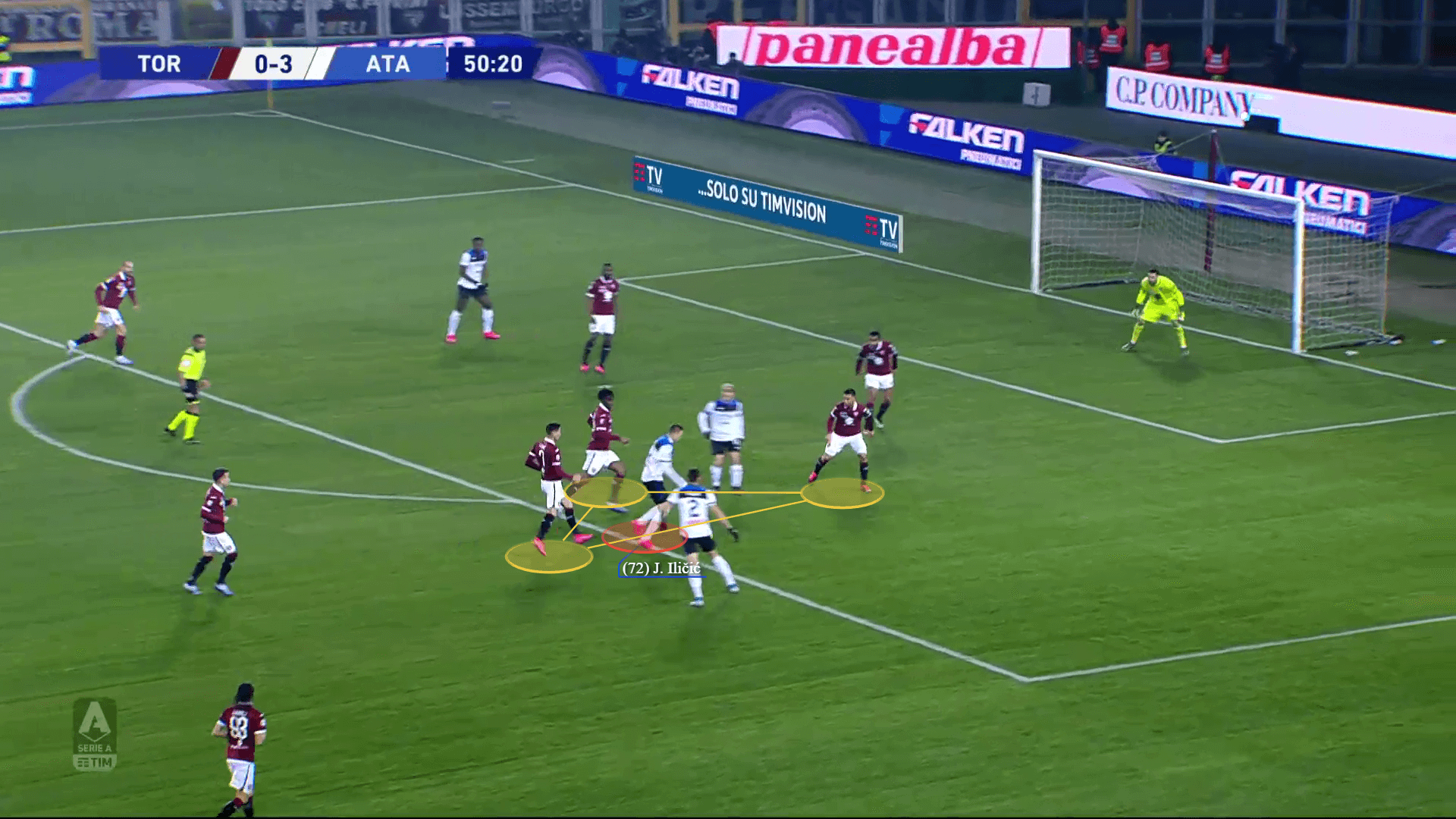
Another issue that occurs all over the pitch is their inability to hold on to the ball. The team are second in the league when it comes to ball losses per 90 minutes. This frequent loss of possession leads to the opposition creating chances without Torino being able to react. Although it happens in the advanced areas too, their biggest problem is that they often lose the ball in their defensive third. This forced some of the players to move out of position and leave gaps, which the opposition could exploit easily.
As mentioned due to their struggles in breaking lines during the build-up, the team often invite pressure in their own half. Their opponents use that very smartly and press high, forcing them to send the ball back quite often. Torino’s inability to sustain pressure results in them losing the ball in key areas. The team also have the second-worst record in progressive passes per 90 minutes in Serie A. The reason behind that is that they fail in their effort to break lines and they often need to switch play or use short lateral passes until they find a gap they could take advantage of.
The lack of defensive support by the midfield line is crucial for their failure. The players often fail to block the passing lanes with their positioning and this helps the opponents to advance the ball smoothly. The Torino players are often easily dragged and their marking strategy doesn’t fulfil its purpose.
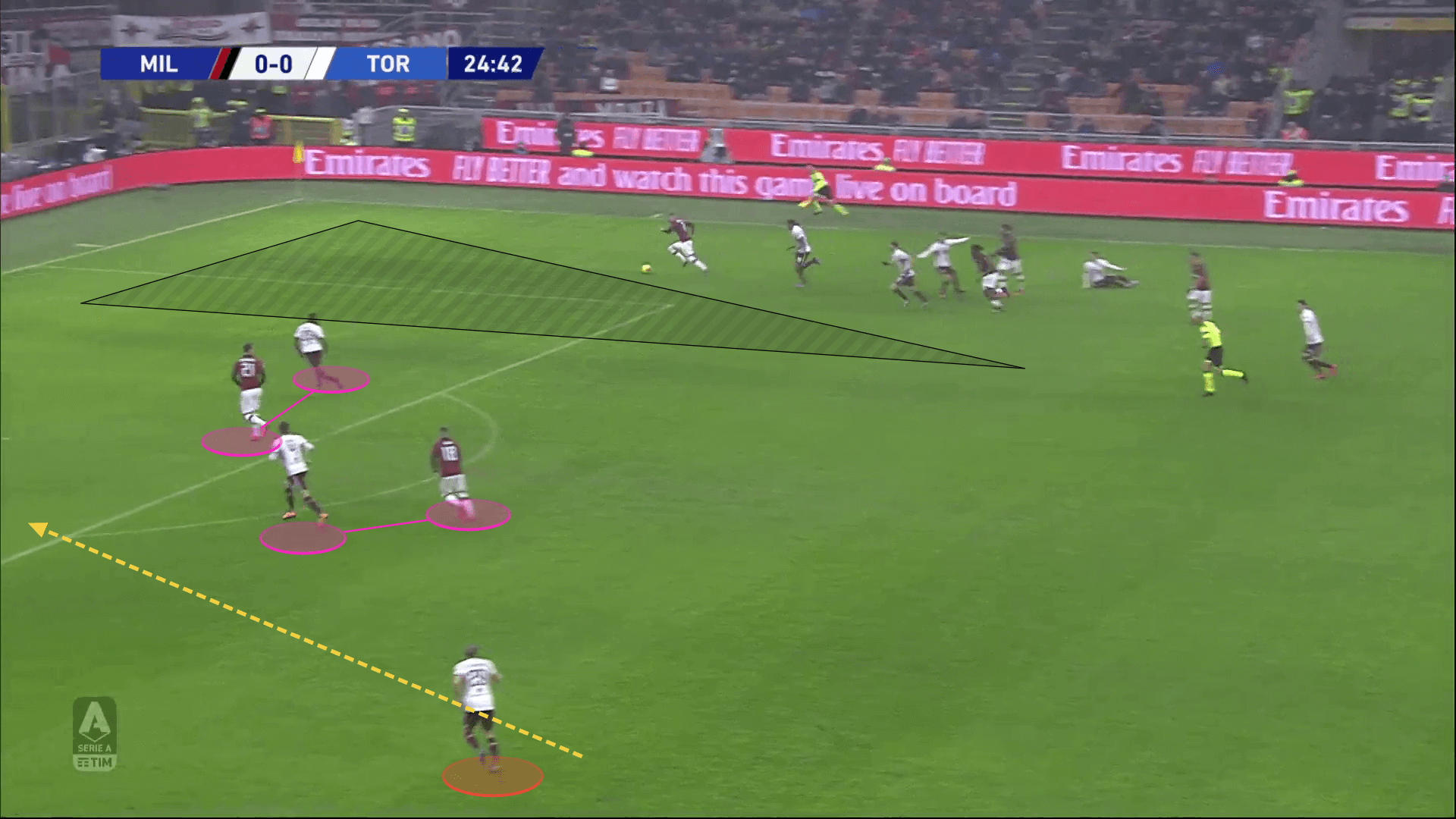
The lack of good replacements on the bench also has its contribution to their poor performance. Torino has conceded the highest number of goals in the last 15 minutes of the games. This could be a result of many things. The starting XI players are exhausted and lack fresh ideas, but it is exactly when some of them are taken off when they start cracking. This puts Torino in quite a difficult situation. If they push their most important players to their limits every time there is a risk of injuries, but also, the substitutions are not sustainable enough and the absence of the starters gets noticeable.
What does the data analysis show?
Looking into their data compared to the other teams in Serie A, things don’t look much better for Torino. They are close to the worst records in many of the indicators which underline why they perform poorly in practice too.
The data truly shows their lack of creativity and chances upfront. Torino holds the second-worst record when it comes to created shots. With their 9.72 efforts per game, it is understandable why their goals rarely come from open play. They do shoot from distance quite often but their efforts are rarely successful.
Torino is among the teams that send the least through balls. Their 5.03 efforts per 90 minutes on average are quite a low rate. But there is something more disturbing. While the frequency rate could be low just due to their strategy of exploiting the wings and crossing, their low accuracy rate is what affects their attacking actions.
They could definitely take advantage of some areas where they perform better and increase their shot efficiency. Torino are leaders in Serie A when it comes to attempted 1vs1 dribbling situations per game. If they improve their success rate and use that to deliver the ball to key areas it would affect their attacking performance immensely.
Their poor actions in defence lead to allowing 15.53 shots on average which is among the highest in the league. The player’s lack of awareness of their opponents’ positioning often results in inaccurate actions. This has also a lot to do with their committed fouls record. Torino commits the most fouls per 90 minutes (15.64) out of all teams. That’s part of the reason for their defensive troubles since they give away a lot of set-piece chances to their opponents.
Conclusion
The analysis shows that Torino might need to work on their connection between the lines and on building a plan-B, hence making in-game adjustments. They have become pretty predictable for their opponents and that really affects their attacking performance. When it comes to defence, the lack of fluidity in their transitions, combined with poor defensive awareness leaves them exposed more and more frequently. Their unmeasured and wrongly timed defensive actions result in committing many fouls which not only give away dangerous opportunities but also interrupt the game flow, making it harder to focus.
The team are yet to play more games under their new coach Longo, and he needs to make a lot of improvements, the most important one being players’ movement during defensive transitions and the connection between midfield and defence.




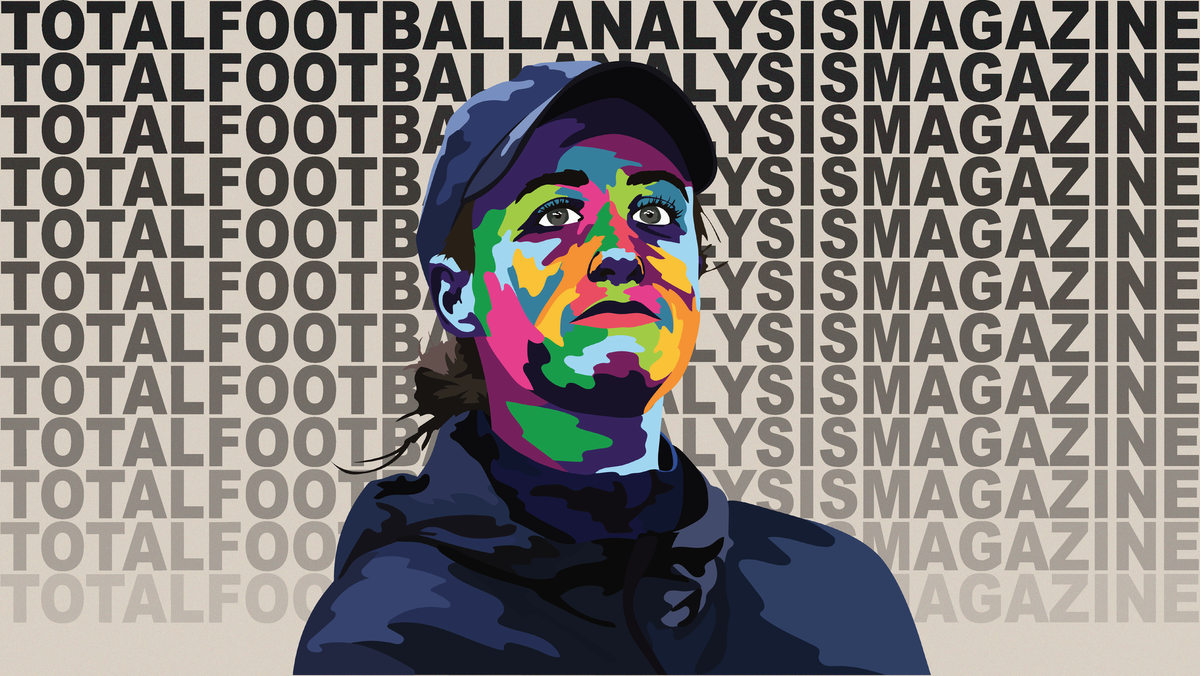
Comments